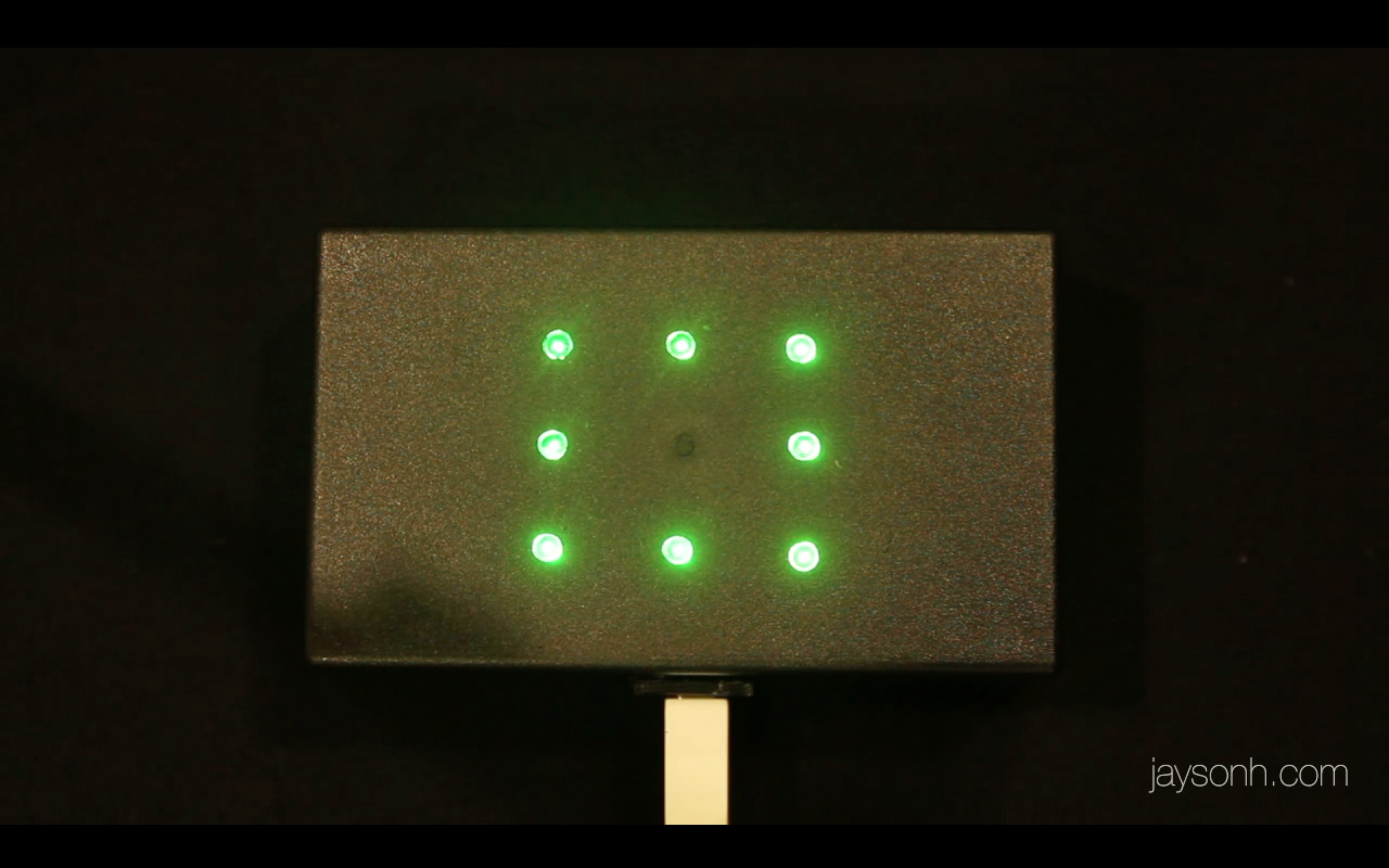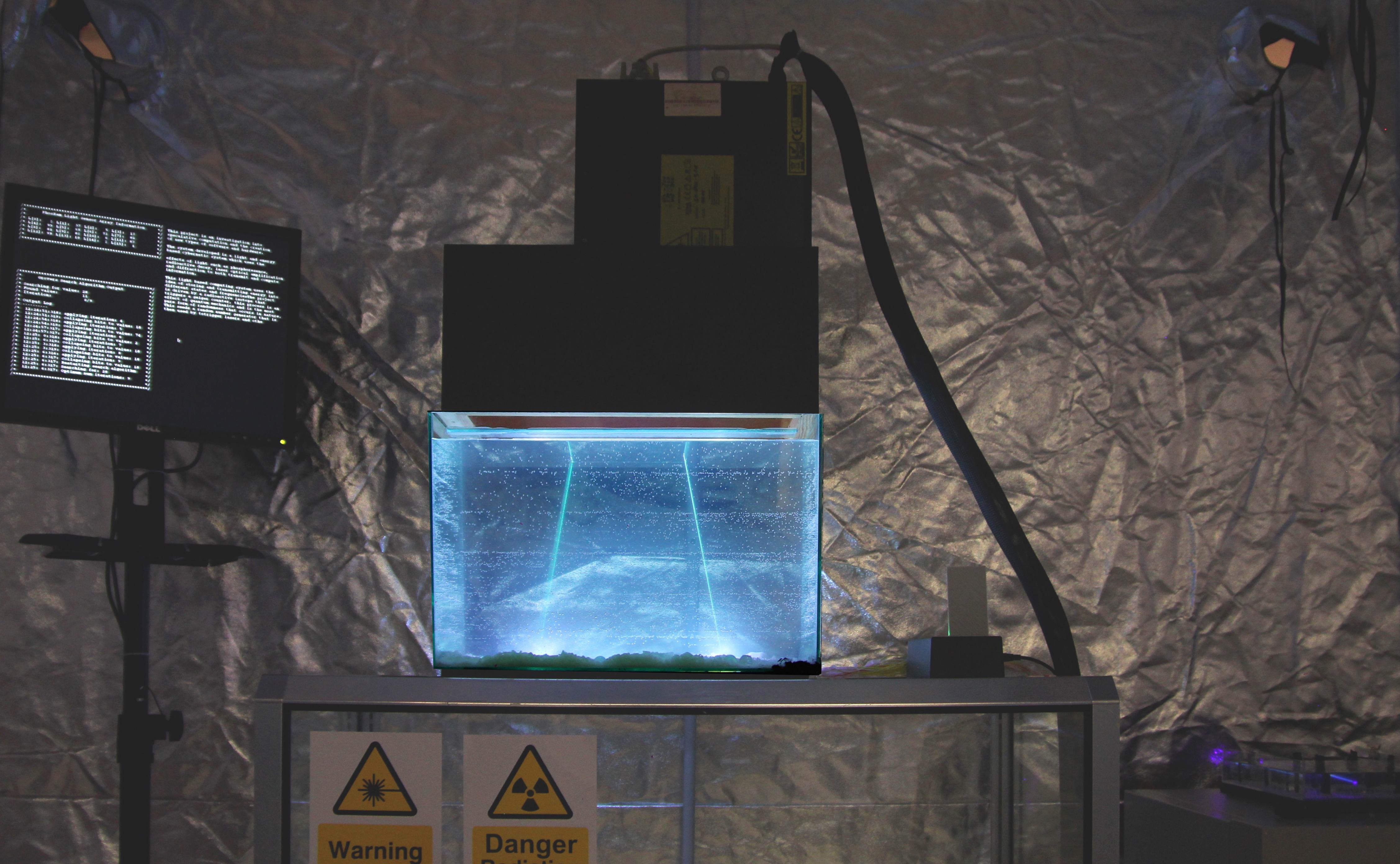Future Applied Technologies®
This is project is an investigation into speculative computing systems. The system developed is a light and energy based cybernetic system which uses the effects of light such as phosphoresence, radioactive decay, laser optical amplification and diffraction to both transmit and compute information.
produced by: Jayson Haebich
Background
This project is inspired by the concept of speculative and theoretical computing. The project started as an investigation into the development of software and hardware for computing systems that do not exist yet and resulted in the development of an example of a light based cybernetic system that may exist in the future.
The aesthetic approach to the final installation piece is inspired by lab aesthetics in which function is the primary objective rather than visual design. This results in a visual experience where the function and usuability of tools, equipment and spaces creates its own distinct visual identity based around science and technology (Archival Aesthetics, 2015).
Project Description
This is a speculative project that imagines what the future of computer hardware and software might be and draws upon different computational theories such as quantum computing, analogue computation and cybernetic theory. The aim of this project is to develop a system that uses different forms of light and energy to do computation. As this is a speculative project the project has been developed as both a scientific and artistic investigation into light based computing rather than being an engineering project, this is because I am interested in the way in which artists can aid in the development of new technology by speculating on what the future might be.
In this project I specifically refer to the method of computing as light based comptuing which uses the idea of storing and transmitting energy into different states and frequencies. The project is driven by a radioactive isotope that triggers a geiger counter, this process is an effect of quantum mechanics and is the most pure form of randomness that occurs in nature. This seeds a random number generator that is then used by to trigger lasers and other lights throughout the system. In the aquarium a laser shines onto phosphorescent stones which act as short term memory units that dissapate the light energy with time. This residual light energy is then detected by photosensors which are feed back into the system as a cybernetic process in which the dissapation of light through Phosphorescent materials acts as a self regulating mechanism on the system (Wiener, N 1948) which is a process also important in analog computing. This concept of self regulation and storage of information in light systems is a further development of the work done by myself and Marija Bozinovska Jones (Bozinovska Jones, M. Haebich, J 2016).
The project is a system cybernetic system comprised of light and energy. In the past first and second order cybernetics have been comprised of machines and living organisms. Furthering this I wanted to create a system based on the physical processes of light that acts in a self regulating way. When referring to light I mean both the visible and invisible spectrums of light such as ultraviolet, gamma amd beta radiation, visible light etc. The overall process of this system is running a quantum search algorithm called grovers search algorithm (Grover, L 1997). The algorithm uses the random decay of the radioactive isotope to drive the quantum algorithm. It also uses the phosphorescent material to store output from the algorithm and read it back in later. The OPTLPU devices uses the routing of ultraviolet laser beams via mirrors and glass to make control decisions while executing the algorithm.
The project has been presented with a specific science/lab visual aesthetic in mind (Archival Aesthetics, 2015), with the reasoning behind this to show my work as if it is a working science prototype. The piece itself is presented within a large metallic tent which amplifies the feeling of being in a sealed/closed environment that protects the fragile cybernetic system from outside electromagnetic radiation. The modules themselves are self contained and I have taken care to present each as an almost finished product but I have deliberately left wires and components connecting the different modules together to expose the raw nature of the project in the same way a demonstration of a new computing technology would be presented in a lab rather than as product.
Technical Implementation/Process
The final piece consists of a number of different modules that are connected together as can be seen in the diagram in the previous section. Each of these modules have been created using a variety of physical computing and software development tools with the overall system being controlled by an openframeworks app running on a computer. The system runs a simple kind of quantum based algorithm called Grovers Search Algorithm (Grover, S 1997) which uses probabilities to search an unstructured data set for a single piece of information. In my installation the light computer is looking for a single 7 bit number out of all possible solutions. This process can be seen on the text output screen.
The diagram in the pictures at the bottom shows the technical layout of the various components of the system with further information about each of the components listed below
Quantum Ionising Capacitor (QIC) - Uranium glass, 3d printed material. This component acts as a kind of battery or source of energy/information that drives the system as a whole. The QIC contains slightly radioactive uranium glass that gives off a steady but completely random stream of radioactive decay that the QSPU detects.
Quantum Seed Processing Unit (QSPU) - Arduino board and code, Geiger Counter Tube, 3D printed components. This component contains a geiger counter tube which detects radioactive decay which due to quantum mechanics is completely random and non deterministic (Loveland, Morrissey 2006). The device then uses this detection to create numbers that seed a random number generator that is used within the quantum algorithm.
Ultra Violet Processing Unit (OTPLPU) - Ultraviolet laser diodes, Arduino Board and code, Quinine infused gel mixture, mirrors, photoreactive sensors. This component mimics a type of optica analog circuit board in which laser beams are controlled by mirrors and diffracted by glass, with different paths through the system giving different results. The resultant beams are then recorded with Photo Resistors that determine the result of the operation.
Phosphorescent Random Access Memory (PHOSRAM) - Phosphorescent plastic, iodine infused liquid, RGB Laser, Etherdream Laser controller, photoreactive sensors. In this module a laser records information onto phosphorecent material on the bottom of the tank that slowly disapates this light. The dissapation is recorded by photoresistors underneath of the tank.
Process
This project has been developed over the past year with some of the hardware developed in my Physical computing class and software developed in the Creative Coding class. The first part of the project that was made was the quantum computing software ofxQuantum which was developed as an addon for openframeworks. From there various hardware components such as the QSPU and PHOSRAM were developed. Finally in preparation for the exhibition all the different components were connected together and a specific visual aesthetic for the presentation of the project was developed.
Challenges Faced/Future Development
One of the main challenges of this project was deciding how much this should be a working computer versus presenting the ideas and concepts to the audience. This could have easily been a project which was based completely around science and the technical implementation of a quantum light based computer, but as I am an artist not a scientists what was most important to me was to build both a conceptual and physical framework for the project.
In the future I would like to possibly further refine different aspects of this project, possibly designing my own light based programming language that uses lasers and mirrors to create an analog optical computing system.
Source code:
Source code available at: https://github.com/jaysonh/FutureAppliedTechnologies
References:
- Hayward, M. (2015), Quantum Algorithms Code, https://quantum-algorithms.herokuapp.com/ Accessed 5th April 2016
- Unknown, (2015). Archival Aesthetics, https://www.facebook.com/groups/542487042544825/ Accessed 14th August 2016
- Wiener, N. (1948). Cybernetics: Or Control and Communication in the Animal and the Machine. Cambridge, MA: MIT Press
- Bozinovska Jones, M. Haebich, J. (2016) Painful is birth, http://marijabozinovskajones.com/again/ Accessed 14th August 2016
- Loveland, W. Morrissey, D. Seaborg, G.T. (2006). Modern Nuclear Chemistry. Wiley-Interscience. p. 57. ISBN 0-471-11532-0.
- Grover, L.K., 1997. Quantum mechanics helps in searching for a needle in a haystack. Physical review letters, 79(2), p.325.







































































